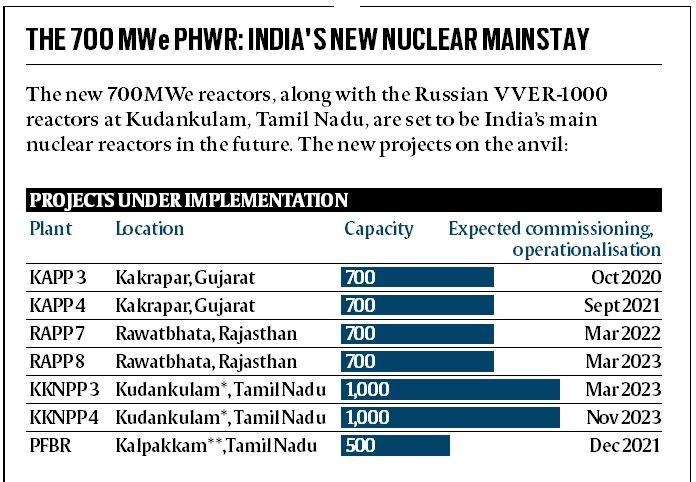Description
Context:
- The third unit of the Kakrapar Atomic Power Project (KAPP-3) in Gujarat achieved its ‘first criticality’.
- First Criticality: It signifies the initiation of a controlled but sustained nuclear fission reaction.
Significance of Achievement:
- KAPP-3 is the country’s first 700 MWe (megawatt electric) unit, and the biggest indigenously developed variant of the Pressurised Heavy Water Reactor (PHWR).
- The PHWRs uses natural uranium as fuel and heavy water as moderator.
- They are the mainstay of India’s nuclear reactor fleet.
- Significant scale-up in technology: The new 700MWe unit addresses the issue of excess thermal margins.
- An improvement in the economies of scale: Significant changes to the design of the 540 MWe reactors.
- As India works to ramp up its existing nuclear power capacity of 6,780 MWe to 22,480 MWe by 2031, the 700MWe capacity would constitute the biggest component of the expansion plan.
Thermal Margins: It refers to the extent to which the operating temperature of the reactor is below its maximum operating temperature.
Future Projects:

Evolution of Pressurised Heavy Water Reactor:
- PHWR technology started in India in the late 1960s with the construction of the first 220 MWe reactors, Rajasthan Atomic Power Station, RAPS-1 under the joint Indo-Canadian nuclear co-operation.
- For the second unit (RAPS-2), import content was reduced considerably, and indigenisation was undertaken for major equipment.
- From the third PHWR unit (Madras Atomic Power Station, MAPS-1) onward, the evolution and indigenisation of the design began.
- The first two units of PHWR using indigenously developed standardised 220 MWe design were set up at the Narora Atomic Power Station.
- To realise economies of scale, the design of 540 MWe PHWR was subsequently developed.
Future:
- Building a 900 MWe Pressurised Water Reactor (PWR) of indigenous design.
India Nuclear Program:
Background:
- Homi Bhaba devised India's three-stage nuclear power program in the 1954.
- It was formulated to provide energy security to India.
- The main aim was to capitalize on India’s vase thorium reserves while accounting for its low uranium reserves.
- India has only about 2% of the global uranium reserves but 25% of the world’s thorium reserves.
The three stages are:
- Natural uranium fuelled Pressurized Heavy Water Reactors (PWHR)
- Fast Breeder Reactors (FBRs) utilizing plutonium based fuel
- Advanced nuclear power systems for utilization of thorium
Stage 1:
- The first stage involved using natural uranium to fuel Pressurized Heavy Water Reactors to produce electricity and producing plutonium-239 as a by-product.
- Using Pressurized Heavy Water Reactors rather than Light Water Reactors was the best choice for India given its infrastructure.
- While Pressurized Heavy Water Reactors used unenriched uranium, Light Water Reactors required enriched uranium.
- The components of PWHR could be domestically manufactured in India, as opposed to LWRs, which would need some components to be imported.
- Furthermore, the by-product plutonium-293 would be used in the second stage.
Stage 2:
- The second stage involves using plutonium-239 to produce mixed-oxide fuel, which would be used in Fast Breeder Reactors.
- These reactors have two processes. Firstly, plutonium 293 undergoes fission to produce energy, and metal oxide is reacted with enriched uranium reacts with mixed-oxide fuel to produce more plutonium-239.
- Furthermore, once a sufficient amount of plutonium-239 is built up, thorium will be used in the reactor, to produce Uranium-233. This uranium is crucial for the third stage.
Stage 3
- The main purpose of stage-3 is to achieve a sustainable nuclear fuel cycle.
- The advance nuclear system would be used a combination of Uranium-233 and Thorium.
- Thus, India's vast thorium would be exploited, using a thermal breeder reactor.
- Currently this stage is still in the research stage.
- Thus, India is looking to simultaneously using its thorium in other technologies.
- The options include Accelerator Driven Systems (ADS), Advanced Heavy Water Reactor (AHWR) and Compact High Temperature Reactor (CHTR).
Current State
- Currently India has 21 reactors that produce 5780 MW, 6 under construction aimed to produce 4300 MW and 33 planned aimed to produce 33000 MW.
- Currently India's installed capacity of energy is 230,000 MW so nuclear energy could form a significant portion of India's energy output.
Reference: https://indianexpress.com/article/explained/kakrapar-atomic-power-project-third-unit-achieves-first-criticality-india-nuclear-mission-6518946/





